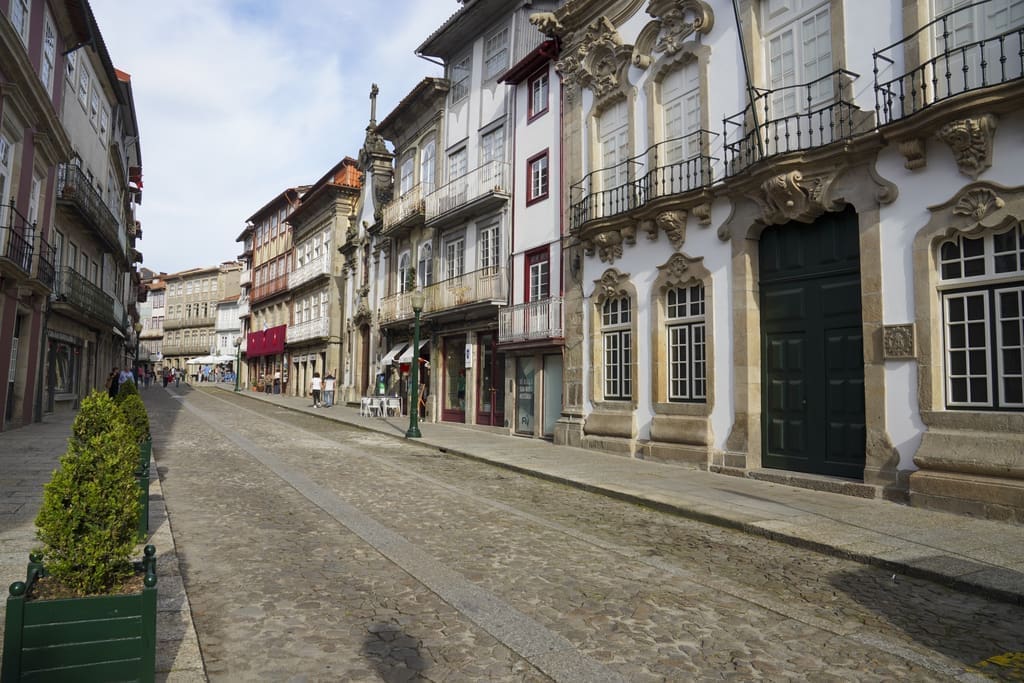In front of the Church of Mercy and to the left we find Rua da Rainha, in honor of Queen D. Maria II, who determined the consideration of Guimarães as a city, on June 22, 1853.
“I would like to elevate the Villa de Guimarães to the category of City with the name of City of Guimarães, and I am pleased that in this capacity it will enjoy all the prerogatives, liberties and freedoms that rightfully belong to it.” – “I would like to elevate the Villa de Guimarães to the category of City with the name of City of Guimarães, and I am pleased that in this capacity it will enjoy all the prerogatives, liberties and freedoms that rightfully belong to it.”
The queen was received at the “Porta da Vila” by an enthusiastic popular demonstration. The then mayor gave him the keys to the city, from where a procession followed to the Collegiate Church of Nossa Senhora da Oliveira, along Rua dos Mercadores (now Rua da Rainha D. Maria II).
The old name of “Rua dos Mercadores” is due to the bustling trade that once existed there, including goldsmiths, tailors, among others.
The entire street is lined with beautiful buildings and houses with wrought iron balconies and granite stone facades, which seem to have stopped in time.
Further ahead, we see on the right a beautiful building: the Casa dos Lobos Machado, with a rocaille style facade, profusely decorated with vigorous and dynamic motifs, with beautiful reliefs made of granite typical of the region, and which contrasts with the whiteness of the walls.
This building was built in the second half of the 18th century and until recently was the headquarters of the Guimarães Commercial and Industrial Association.
In a very narrow alley after the Casa dos Lobos Machado, there is the Capilla do Anjo, or St. Crispim, founded in 1315 by two master shoemakers, who had their trade in this street. Next to it was founded the Albergaria Hospital, which welcomed the poor and gave shelter to pilgrims on their way to Santiago de Compostela.
In 1786 the Brotherhood of St. Crispim and St. Crispiniano was created, which maintains an ancient tradition to this day, serving the poor and disadvantaged of the city every year on Christmas Eve, in the Albergue de St. Crispin.
This alley where the hostel is located leads to a small square. In the 1930s, when streets were opened and spaces were enlarged to make the city healthier, the Almadas family house was partially demolished. From a series of demolitions, the current Largo da Tulha was formed.
According to history, a three-storey granite tower with a hipped roof and no windows overlooking the square was left exposed: the Torre dos Almadas. In addition to continuing to function as a dwelling, the interior space was shared by the neighbourhood’s dwellings, leaving the tower isolated.
In 1964, at the proposal of the first president of the “Velhos Nicolinos”, António Faria Martins, it was decided that the space would be ceded for a period of 50 years to the “Association of Former Students of the Liceu de Guimarães”. The Chamber ceded the property in 1968 for the headquarters of this institution, which is still dedicated to maintaining the tradition of Guimarães, encouraging students who attend Secondary Education in Guimarães to hold the Annual Nicolina Festivals.

 Guimarães, Northern Portugal
Guimarães, Northern Portugal











 Guimarães Turismo
Guimarães Turismo 




